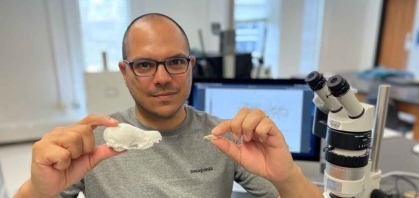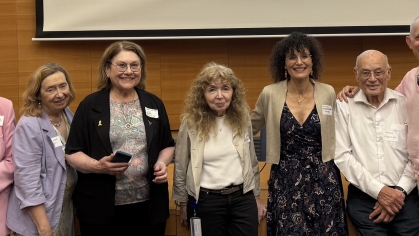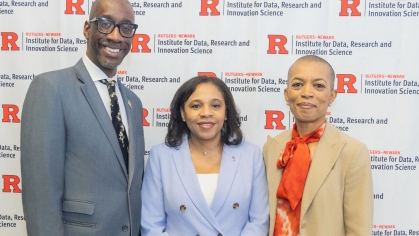Scientist’s Roots in Puerto Rico Shaped His Research on Biodiversity

Angelo Soto-Centeno explores how different species evolve, why some last and others become extinct. Bats provide a fascinating window into the process, says Soto-Centeno, who specializes in studying them. Growing up in Puerto Rico surrounded by wildlife, Soto-Centano believes his cultural background and heritage has played an important role in his work. He is an assistant professor of evolution in the Department of Earth & Environmental Science in the School of Arts & Science-Newark (SASN).
What is the focus of your research and its potential impact?
My studies fall at the interface of speciation and extinction. They are motivated by my passion for biodiversity, and I try to find answers to two main questions: How are new species formed? Why do some species become extinct, but others survive? We know that there are many species awaiting discovery. Also, we know that species are becoming extinct at an alarmingly fast rate. So, my work is broadly relevant to these issues and has a direct impact on our understanding of this current biodiversity crisis that is mainly caused by human actions.
What inspired you to focus on this particular area of research, and what inspires you now?
At my core, I am inspired by how biodiverse our planet is. I became interested in animals (particularly flying ones) at an early age, and I have retained that passion over the years. This is what really drew me to study evolutionary biology. I believe there are many incredibly intriguing aspects about animals. Like, how many species are there? Or why do they live in the places we see them today? Finding the answers to these types of questions drives my inspiration every day.
In what ways has your background, culture, and heritage impacted who you are and the research you do?
I do see my cultural background and heritage playing a role in shaping my work. I was born and raised in Puerto Rico and did my undergraduate degree there. I am a first-generation college graduate and pretty much all my immediate family still lives on the island. Things were different there when I began doing research. It was very much driven like what we call “ciencia criolla” [a term meaning projects led by Latin American scientists]. This is a bit tough to describe, but maybe you could imagine it as a very hands-on research experience in a makeshift way. This was because many of the resources we needed for doing research were too difficult to attain, so we were forced to wear different hats beyond just being a scientist and find solutions to problems in creative ways. It was an absolute “házlo como puedas, y no te rindas” [do your best, and do not give up] attitude. Today, I bring this same creativity and tireless attitude to all my work.
What has your experience been like as a Hispanic/Latinx person working in research or in your field of research?
When I was an undergrad, there were few students working in the field of ecology and evolution. From the undergraduates participating as research assistants in that cohort, I was the only one making it into academia this far. Even today, in many of the circles I am involved in, I often see myself either being the only Hispanic, or one of a handful of us. Over the years I have seen an increase in Hispanics and Latinx in these fields. Because of this, I have been able to create larger networks of collaborators, and it has allowed me to provide significant opportunities to aspiring scientists of a similar cultural background and heritage to mine. This to me has been one of the most important reasons for staying in academia. I think that has made my experience in this field more welcoming, although I could not say it has been free of challenges.
How can diversity and inclusion in academia and within research universities be improved?
This is a very complex question, and I believe there could be many equally valid ways to improve diversity and inclusion in research and academic settings. One way in which I think this can be improved is by providing equal opportunities to Hispanics and Latinx, and also acknowledging that the challenges we have in our line of work are very different than those experienced by other groups. For example, studies have shown that non-native English-speaking scientists take a considerably longer amount of time to do certain tasks, like reviewing a research manuscript or writing a grant, only because they are doing it in a second language. Providing mentoring and professional development opportunities that are tailored to the specific challenges we face could help improve our productivity, reduce burnout, and/or mental health issues.
What do you feel is the most critical issue facing people of Hispanic/Latinx heritage in higher ed, and what do you believe could and/or should be done about it?
I think a critical issue facing Hispanics and Latinx in the higher ed science field is the lack of appropriate mentors and role models. This affects us at all levels. Recent polls have shown that STEM students associate their lack of connection with these fields to experiences of discouragement or mistreatment in the classroom during college years. These experiences prevent the development of a sense of belonging in STEM communities. Furthermore, pedagogical research has shown that students learn better when taught by someone who shares a similar cultural background and upbringing. Diverse instructors or researchers can thus have a positive impact in the way students perceive STEM fields and in creating environments in which students feel empowered to pursue a career in these fields. Increasing exposure of Hispanics and Latinx mentors in higher ed science may help create opportunities for students to find the appropriate mentors and role models and possibly increase retention in STEM careers.


